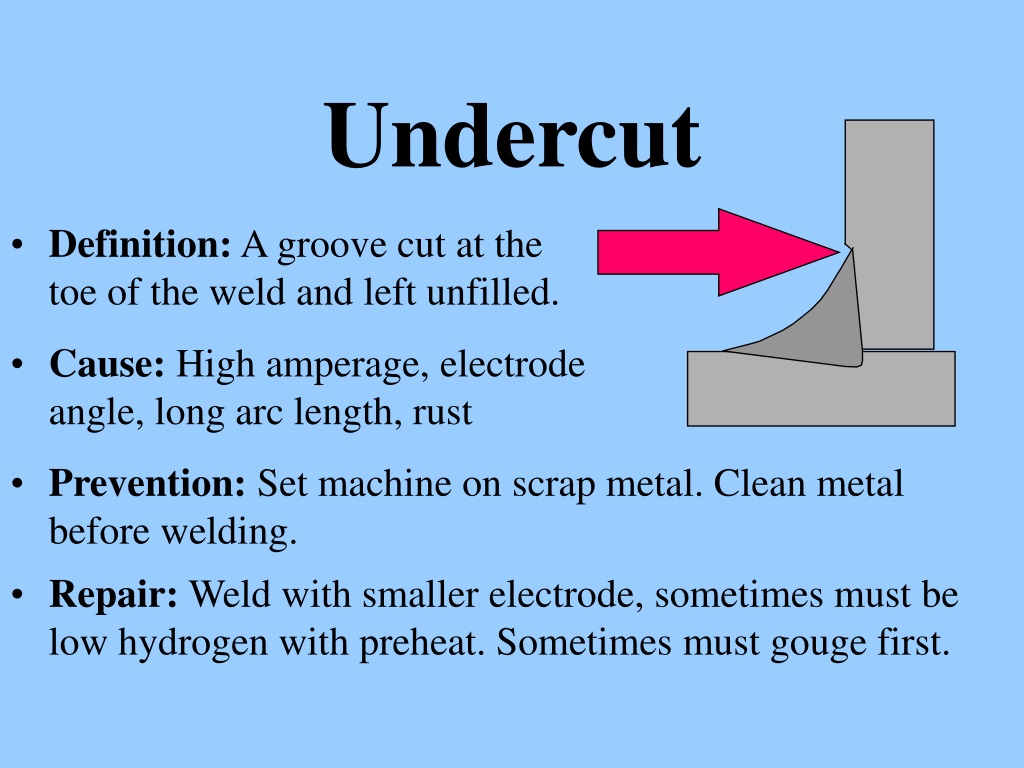A Comprehensive Overview to Identifying, Averting, and Dealing With Undercut Welding Problems in Your Welding Tasks
In the realm of welding, running into undercut issues is a typical difficulty that can compromise the architectural stability and total quality of your welding jobs. Remain tuned as we discover the necessary elements of identifying, protecting against, and taking care of undercut welding issues, giving you with valuable understandings and techniques to elevate your welding abilities to the following degree.
Common Root Causes Of Undercut Welding
Undercut welding, a common problem in welding procedures, can be brought on by various factors that need to be thoroughly identified and dealt with to make certain the stability of the weld joint. One of the main root causes of undercut welding is excessive heat input. When the welding specifications, such as voltage, existing, or take a trip rate, are not properly set, an extreme quantity of warm can be created. This excess warm causes the melting and subsequent elimination of the base product along the edges of the weld joint, creating a groove referred to as undercut.
One more common root cause of undercut welding is incorrect welding method. Inadequate adjustment of the welding lantern or gun, wrong angle or distance between the lantern and the workpiece, or irregular traveling speed can all contribute to the formation of undercut. Furthermore, using the incorrect welding consumables or electrode dimension for a particular joint configuration can lead to undercut concerns. Determining these root causes and executing restorative measures is important in stopping and fixing undercut welding issues in welding jobs.
Identifying Undercut in Welds

To identify undercut properly, correct lights and zoom tools are essential to examine the weld joint thoroughly. Making use of tools such as a welding scale or a magnifying glass can aid in spotting even the smallest undercut imperfections. Additionally, running a finger or a fingernail along the weld joint can often disclose undercut, as the surface area may really feel unequal or have a dip where the undercut exists.
Preventive Measures for Undercut
Having a deep understanding of the reasons of undercut in welds enables for the execution of effective preventive actions to maintain weld high quality and stability. These setups need to be enhanced to prevent too much warmth input, which can lead to undercut development.

Strategies for Repairing Undercut

Enhancing the welding current or decreasing the traveling rate can read the article aid fill in the undercut. Additionally, changing the welding method from a press to a drag or vice versa can additionally help minimize undercut.
One more technique is to make use of a weaving activity while welding to make certain appropriate sidewall fusion and fill in the undercut. By oscillating the welding arc back and forth within the weld joint, the welder can transfer a lot more filler product right into the undercut locations, successfully removing the defect.
Furthermore, grinding out the undercut and rewelding the joint can be a sensible option for more serious undercut problems - Preventing weld undercut. This procedure entails eliminating the undercut area, preparing the base steel, and after that rewelding the joint with correct welding parameters and methods to stop undercut from persisting

Specialist Tips for Staying Clear Of Undercut
Making use of appropriate welding techniques and keeping control over crucial welding criteria are crucial methods for welders aiming to avoid undercut in their weld joints. One expert idea for staying clear of undercut is to make certain correct joint preparation. This includes cleansing the base steel thoroughly to eliminate any impurities that can result in damage formation. Additionally, selecting the ideal welding process and filler steel for the details application can assist next prevent undercut. Welders must also pay attention to the welding current and voltage settings, guaranteeing they are within the suggested array to avoid overheating and potential undercut. Maintaining a constant travel speed during the welding procedure is an additional vital suggestion to avoid undercut. By moving at a steady rate, welders can ensure appropriate blend and lower the likelihood of undercut development. Finally, inspecting the weld bead after conclusion can help determine any kind of signs of undercut beforehand, permitting for instant restorative action to be taken.
Final Thought
To conclude, identifying, avoiding, and repairing undercut welding problems in your welding tasks is essential for guaranteeing strong and long lasting welds. Preventing weld undercut. By recognizing the typical root causes of undercut, having the ability to identify it in welds, implementing safety nets, and utilizing proper methods for repairing undercut, you can stay clear of prospective problems and create top quality welds. Following expert pointers for avoiding undercut can assist you boost your welding skills and create much better cause your projects
Undercut welding, a typical concern in welding processes, can be triggered by various factors that require to be thoroughly identified and addressed to guarantee the honesty of the weld joint. Additionally, running a finger or a fingernail along the weld joint can occasionally disclose undercut, as the surface area may feel uneven or have a dip where the undercut exists.
Utilizing correct welding techniques and maintaining control over key welding specifications are critical strategies for welders intending to stop undercut in their weld joints.In conclusion, determining, stopping, and repairing undercut welding issues in your welding projects is vital for ensuring long lasting and solid welds. By comprehending the common causes of undercut, being able to identify it in welds, implementing precautionary measures, and utilizing appropriate methods for taking care of undercut, you can avoid possible issues and create top notch welds.